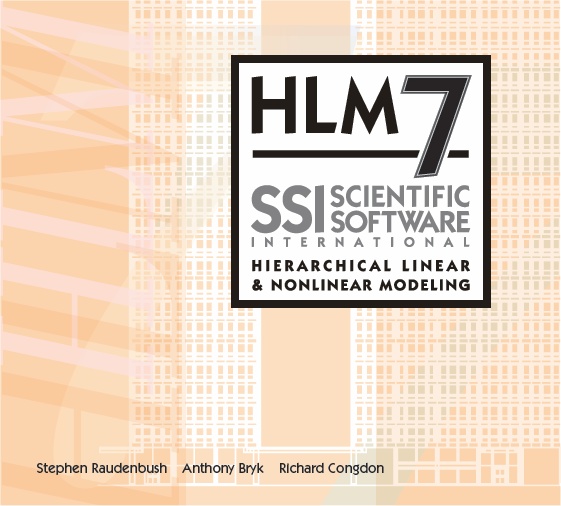

In social research and other fields, research data often have a hierarchical structure. That is, the individual subjects of study may be classified or arranged in groups which themselves have qualities that influence the study. In this case, the individuals can be seen as level-1 units of study, and the groups into which they are arranged are level-2 units. This may be extended further, with level-2 units organized into yet another set of units at a third level. Examples of this abound in areas such as education (students at level 1, schools at level 2, and school districts at level 3) and sociology (individuals at level 1, neighborhoods at level 2). It is clear that the analysis of such data requires specialized software. Hierarchical linear and nonlinear models (also called multilevel models) have been developed to allow for the study of relationships at any level in a single analysis, while not ignoring the variability associated with each level of the hierarchy.
The HLM program can fit models to outcome variables that generate a linear model with explanatory variables that account for variations at each level, utilizing variables specified at each level. HLM not only estimates model coefficients at each level, but it also predicts the random effects associated with each sampling unit at every level. While commonly used in education research due to the prevalence of hierarchical structures in data from this field, it is suitable for use with data from any research field that have a hierarchical structure. This includes longitudinal analysis, in which an individual’s repeated measurements can be nested within the individuals being studied. In addition, although the examples above implies that members of this hierarchy at any of the levels are nested exclusively within a member at a higher level, HLM can also provide for a situation where membership is not necessarily “nested”, but “crossed”, as is the case when a student may have been a member of various classrooms during the duration of a study period.
The HLM program allows for continuous, count, ordinal, and nominal outcome variables and assumes a functional relationship between the expectation of the outcome and a linear combination of a set of explanatory variables. This relationship is defined by a suitable link function, for example, the identity link (continuous outcomes) or logit link (binary outcomes).
Please note that the installation application on this page is only for end users with active activation codes for HLM 7.00 for Windows.
The list of changes/corrections implemented in HLM 7.01 for Windows are listed below.
General:
Output formatting errors fixed.
Reads SAV files up to SPSS 21 for Windows.
Reads DTA files up to STATA 12 for Windows.
HLM2:
Fixed error in fixed effects degrees of freedom when data are missing.
Error in ordinal level-1 residual files fixed.
Error in plausible values runs fixed.
HLM3:
Fixed error in fixed effects degrees of freedom when data are missing.
Various fixes to residual files.
Error in plausible values runs fixed.
HLM4:
Fixed a Chi-square table printing error.
Problem with making graph files fixed.
HMLM2:
Fixed error in centering of level-1 variables.
HCM3:
Fixed error in computation of Binomial/Poisson models.
Instructions
Use the Windows Control Panel to uninstall HLM 7.00 for Windows.
Delete the HLM7 folder in C:Program Files (x86) if it was not removed in the first step.
Use the URL below to save the installation application HLM7Setup.exe to a USB flash drive.
Ensure that the saved application is approximately 37,687 KB in size. If not, please save it again.
Click on the Run as Administrator option on the right-click menu of HLM7Setup.exe on the USB drive.
Delete HLM7Setup.exe from the USB flash drive.
HLM 7 is Compatible with Windows 7. It has successfully passed Microsoft designed tests for compatibility and reliability on Windows 7. It can be used on both the 32-bit and 64-bit editions. Compatible with Windows 7 products install without worry and run reliably with Windows 7.
HLM 7 is Compatible with Windows 8. It has been tested on Windows 8 and no problems were reported
Microsoft has awarded SSI’s HLM software its prestigious Certified for Windows Vista logo. Only applications that pass rigorous testing procedures for compatibility, functionality, and reliability on Windows Vista-based personal computers are granted this logo.
© Copyright 2005-2024, Scientific Software International, Inc.
Il software HLM può essere utilizzato per stimare modelli di dati con struttura gerarchica a vari livelli – per esempio dati in cui sono rilevanti sia le caratteristiche degli individui, sia quelle di vari gruppi in cui gli individui possono essere classificati.

